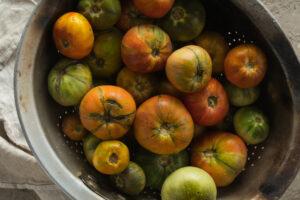
In the Spring of 2015, greenhouse tomato plants grown in Jordan presented with a mosaic pattern of light and dark green patches on leaves, narrowing leaves, and yellow- and brown-spotted fruit (Salem et al. 2015). The pathogen was identified as a novel plant virus, the tomato brown rugose fruit virus (ToBRFV), and the original outbreak was traced back to the fall of 2014 to Israel (Luria et al. 2017). This newly emerging virus can infect tomato and pepper plants at any stage of development and greatly affect crop yield and quality. Furthermore, the virus spreads rapidly by mechanical contact but can also be spread over long distances by contaminated seeds (Caruso et al. 2022), and as of 2022 it had been detected in 35 countries across four continents (Zhang et al. 2022). Compounding its transmissibility, is the ability of the virus escape plant genetic resistance to viral infection (Zhang et al. 2022). There are seven host plants for the virus, including some common grasses and weeds, which could act as a reservoir for the virus, even if it is eliminated from commercial crops. Some researchers consider ToBRFV to be the most serious threat to tomato production in the world.
Control, Managment and Detection of ToBRV
Currently there are no chemical methods to control ToBRFV, and control and management focuses on using certified virus-free seeds and planting materials, implementing strict protocols to minimize transmission, monitoring crops to detect the virus before it can spread, safely disposing of infected plants, and implementing crop rotation and barrier crops. Because monitoring and early detection are critical to control, highly sensitive and automatable methods to detect the presence of the ToBRFV are essential.
One of the most sensitive means of detecting the presence of a microorganism in an environmental sample is by real-time or quantitative RT-PCR (RT-qPCR). RT-qPCR is used successfully around the world to detect the presence of microbial pathogens in wastewater for public health information because of its extreme sensitivity. RT-qPCR relies on RNA as the input material for the assay. RNA is an unstable molecule that is often degraded in environmental samples, so being able to isolate RNA that is intact enough for a downstream PCR assay requires a reliable, repeatable method of isolation. Isolating RNA from a tremendous number of plant samples in an industrial greenhouse production system requires automation to screen as often and thoroughly as necessary to prevent disease spread.
The French Agency for Food, Environmental and Occupational Health & Safety (ANSES) recently released “Detection of Tomato Brown Rugose Fruit Virus (ToBRFV) by Real-Time RT-PCR in Host Plants” which describes a detailed method for detecting ToBRFV in tomato plants. The method emphasizes safety precautions to prevent spread of the virus during testing and describes specific procedures for sample prep, RNA extraction and RT-qPCR assays.
Automated extraction using the Promega Maxwell® HT simplyRNA Kit and the KingFisher instrument is validated automated for leaf, fruit and seed samples in the ANSES recommended protocol.
Summary
The key to managing potentially devastating emerging pathogens lies first in their detection to prevent spread while effective control measures are developed. Automating sample processing and detection assays efficiently and reliably will be key to staying ahead of the spread of devastating pathogens.
Learn more about Promega tools and reagents for plant pathogen detection.
Literature Cited
- Salem, N. et al. (2016) A new tobamovirus infecting tomato crops in Jord https://onlinelibrary.wiley.com/doi/full/10.1111/aab.12788 an. Arch. Virol. 161 503–506.
- Luria et al. (2017) A new Israeli tobamovirus isolate infects tomato plants harboring Tm-22 resistance genes. PLOS One 12(e01704).
- Caruso, A.G. et al. (2022) Tomato brown rugose fruit virus: A pathogen that is changing tomato production worldwide. Annals of Appl. Biol. 181(3): 258–74.
- Zhang et al. (2022) Tomato brown rugose fruit virus: An emerging and rapidly spreading plant RNA virus that threatens tomato production worldwide Mol. Plant Path. 23(9): 1262–77.
Michele Arduengo
Latest posts by Michele Arduengo (see all)
- The Casual Catalyst: Science Conversations and Cafes - July 18, 2024
- Cancer Moonshot: Solving Tough Problems - May 28, 2024
- Automated Sampling and Detection of ToBRFV: An Emerging Tomato Virus - April 25, 2024
